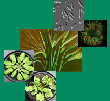Cues affecting the foraging behaviour of the parasitoid Eurytoma serratulae for its host Urophora cardui
Grako 678 "Ökologische Bedeutung von Wirk- und Signalstoffen bei Insekten", Teilprojekt B 4
From 07/2004 to 06/2007Principal Investigator: Erwin Beck
Parasitoids which are mostly specialists are usually confronted with a serious problem: To locate their host in spite of its various strategies to escape detection. In his thesis Marc Böheim is searching for crucial cues by which the wasp Eurytoma serratulae can locate the young larvae of the gall fly Urophora cardui in the interior of a bud of the creeping thistle Cirsium arvense. Upon herbivore attack, many plants react with a change of emitted volatiles. Recognizing the whole bouquet or individual components thereof, interacting insects may focus their foraging behaviour towards the source of the cues. This strategy has been demonstrated for Urophora cardui, the host of E. serratulae. Whether this cue is also sufficient for E. serratulae has to be elucidated in the wind channel and by electrophysiological methods. Since oviposition by E. serratulae takes place at a stage when the initiation of a stem gall by U. cardui larvae is not yet to be recognized, visual structures can be excluded as cues for the location of the host. However, a change of the emission spectra of the thistle stem after a small change of the anatomical structure of the gall-foming tissue can not be completely ruled out. Therefore the emission spectra of unscathed and of parasitized lateral shoots of Cirsium arvense will be compared with a radiospectrometer. Parasitoids can also use vibrational cues to located hidden hosts.


